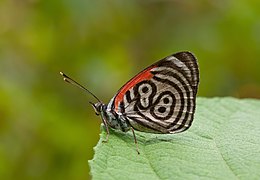Portal:Venezuela
The Venezuela Portal Venezuela, officially the Bolivarian Republic of Venezuela, is a country on the northern coast of South America, consisting of a continental landmass and many islands and islets in the Caribbean Sea. It comprises an area of 916,445 km2 (353,841 sq mi), and its population was estimated at 29 million in 2022. The capital and largest urban agglomeration is the city of Caracas. The continental territory is bordered on the north by the Caribbean Sea and the Atlantic Ocean, on the west by Colombia, Brazil on the south, Trinidad and Tobago to the north-east and on the east by Guyana. Venezuela is a presidential republic consisting of 23 states, the Capital District and federal dependencies covering Venezuela's offshore islands. Venezuela is among the most urbanized countries in Latin America; the vast majority of Venezuelans live in the cities of the north and in the capital. The territory of Venezuela was colonized by Spain in 1522 amid resistance from Indigenous peoples. In 1811, it became one of the first Spanish-American territories to declare independence from the Spanish and to form part of the first federal Republic of Colombia (Gran Colombia). It separated as a full sovereign country in 1830. During the 19th century, Venezuela suffered political turmoil and autocracy, remaining dominated by regional military dictators until the mid-20th century. From 1958, the country had a series of democratic governments, as an exception where most of the region was ruled by military dictatorships, and the period was characterized by economic prosperity. The 2024 presidential election were not recognized by the Carter Center and Organization of American States due to the lack of granular results, and disputed by the opposition, leading to protests across the country. (Full article...) Selected article -The Aula Magna is an auditorium at the Central University of Venezuela. It is located within the University City of Caracas, next to the University's main library building. The hall was designed by the Venezuelan architect Carlos Raúl Villanueva in the 1940s and built by the Danish company Christiani & Nielsen from 1952–53. It was declared a UNESCO World Heritage Site in November 2000 for being artistically and architecturally significant. The most notable feature of the hall is its acoustic 'clouds', which serve both aesthetic and practical functions. They are an element of the hall's design which contributed to the science of interior space acoustics, though the building exterior is also architecturally significant. The Aula Magna has been named the "most important auditorium" at the university. This is in part because of practicality: it is the largest capacity auditorium, being able to hold approximately 2,700 people with removable seats. However, it is also significant because of the academic, artistic, and political events which have taken place within it. Some of these events have been of great importance for the country and some have been part of historical movements. In present-day Caracas, the hall has been a site of political controversy, as well as suffering from a lack of maintenance funds. (Full article...) Selected picture
Plaza Francia, also known as "Plaza Altamira", is a public space located in Altamira, east Caracas. It was built at the beginning of the 1940s and opened on August 11, 1945 with the name "Plaza Altamira". Its name was later changed due to an agreement between the cities of Caracas and Paris to have a Venezuela Square in Paris and a France Square in Caracas.
Selected biography -Lorena Telpuk, formerly María del Luján Telpuk (sometimes María de Luján Telpuk) or the Suitcase Girl (born c. 1981), is a former airport police officer at Aeroparque Jorge Newbery in Buenos Aires, Argentina, who noticed a suitcase with US$800,000 as it went through an X-ray machine in August 2007, initiating a very public international election scandal, known as Maletinazo. When the suitcase scandal became public, Telpuk became an international celebrity, appearing on the cover of several magazines, including those of the February 2008 issue of the Argentine edition of Playboy magazine and the March 2008 issue of the Venezuelan edition of Playboy magazine. (Full article...) In this month...
Did you know (auto-generated) -
Selected list - This is a list of the bird species recorded in Venezuela. The avifauna of Venezuela has 1413 confirmed species, of which 45 are endemic, six have been introduced by humans, 48 are rare or vagrants, and one has been extirpated. An additional 20 species are hypothetical (see below). Except as an entry is cited otherwise, the list of species is that of the South American Classification Committee (SACC) of the American Ornithological Society. The list's taxonomic treatment (designation and sequence of orders, families, and species) and nomenclature (common and scientific names) are also those of the SACC unless noted otherwise. Capitalization within English names follows Wikipedia practice, i.e. only the first word of a name is capitalized unless a place name such as São Paulo is used. (Full article...) Current events
More did you know...
TopicsCategoriesRecognized content
Featured articlesGood articles
Featured pictures
New articlesThis list was generated from these rules. Questions and feedback are always welcome! The search is being run daily with the most recent ~14 days of results. Note: Some articles may not be relevant to this project.
Rules | Match log | Results page (for watching) | Last updated: 2024-11-20 22:59 (UTC) Note: The list display can now be customized by each user. See List display personalization for details.
Things you can doWikiProjects
Related portalsAssociated WikimediaThe following Wikimedia Foundation sister projects provide more on this subject:
Discover Wikipedia using portals |





































